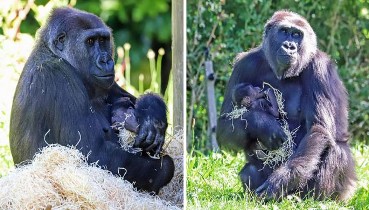
Scientists Extracted Liquid Blood From 42,000-Year-Old Foal Found in Siberian Permafrost
The scientists extracted liquid blood samples from the 42,000-year-old animal’s heart vessels (Semyon Grigoryev/North-Eastern Federal University)
The foal likely drowned in a “natural trap” of sorts-namely, mud that later froze into permafrost, Semyon Grigoryev of Yakutia’s Mammoth Museum told Russian news agency TASS, as reported by the Siberian Times.
“A lot of mud and silt which the foal gulped during the last seconds of the foal’s life were found inside its gastrointestinal tract,” Grigoryev says.
Researchers collect liquid blood from the ice age foal found frozen in Siberian permafrost.
This is only the second time researchers have extracted liquid blood from the remains of prehistoric creatures. In 2013, a group of Russian scientists accomplished the same feat using the body of a 15,000-year-old female woolly mammoth discovered by Grigoryev and his colleagues in 2013, as George Dvorsky reports for Gizmodo.
(It’s worth noting that the team studying the foal has also expressed hopes of cloning a woolly mammoth.) Significantly, the foal’s blood is a staggering 27,000 years older than this previous sample.
The NEFU and South Korean scientists behind the new research are so confident of their success that they have already begun searching for a surrogate mare to carry the cloned Lena horse and, in the words of the Siberian Times, fulfill “the historic role of giving birth to the comeback species.”
It’s worth noting, however, that any acclaim is premature and, as Dvorsky writes, indicative of the “typical unbridled enthusiasm” seen in the Russian news outlet’s reports.
Speaking with CNN’s Mezzofiore, Grigoryev himself expressed doubts about the researcher’s chances, explaining, “I think that even the unique preservation of blood is absolutely hopeless for cloning purposes since the main blood cells … do not have nuclei with DNA.”
He continued, “We are trying to find intact cells in muscle tissue and internal organs that are also very well-preserved.”
What the Siberian Times fails to address are the manifold “ethical and technological” questions raised by reviving long-gone species. Among other concerns, according to Dvorsky, scientists have cited the clone’s diminished quality of life, issues of genetic diversity and inbreeding, and the absence of an adequate Ice Age habitat.
It remains to be seen whether the Russian-South Korean team can actually deliver on its ambitious goal. Still, if the purported July 2018 resurrection of two similarly aged 40,000-year-old roundworms “defrosted” after millennia in the Arctic permafrost is any indication, the revival of ancient animals is becoming an increasingly realistic possibility.
The foal likely drowned in a “natural trap” of sorts-namely, mud that later froze into permafrost, Semyon Grigoryev of Yakutia’s Mammoth Museum told Russian news agency TASS, as reported by the Siberian Times.
“A lot of mud and silt which the foal gulped during the last seconds of the foal’s life were found inside its gastrointestinal tract,” Grigoryev says.
Researchers collect liquid blood from the ice age foal found frozen in Siberian permafrost.
This is only the second time researchers have extracted liquid blood from the remains of prehistoric creatures. In 2013, a group of Russian scientists accomplished the same feat using the body of a 15,000-year-old female woolly mammoth discovered by Grigoryev and his colleagues in 2013, as George Dvorsky reports for Gizmodo.
(It’s worth noting that the team studying the foal has also expressed hopes of cloning a woolly mammoth.) Significantly, the foal’s blood is a staggering 27,000 years older than this previous sample.
The NEFU and South Korean scientists behind the new research are so confident of their success that they have already begun searching for a surrogate mare to carry the cloned Lena horse and, in the words of the Siberian Times, fulfill “the historic role of giving birth to the comeback species.”
It’s worth noting, however, that any acclaim is premature and, as Dvorsky writes, indicative of the “typical unbridled enthusiasm” seen in the Russian news outlet’s reports.
Speaking with CNN’s Mezzofiore, Grigoryev himself expressed doubts about the researcher’s chances, explaining, “I think that even the unique preservation of blood is absolutely hopeless for cloning purposes since the main blood cells … do not have nuclei with DNA.”
He continued, “We are trying to find intact cells in muscle tissue and internal organs that are also very well-preserved.”
What the Siberian Times fails to address are the manifold “ethical and technological” questions raised by reviving long-gone species. Among other concerns, according to Dvorsky, scientists have cited the clone’s diminished quality of life, issues of genetic diversity and inbreeding, and the absence of an adequate Ice Age habitat.
It remains to be seen whether the Russian-South Korean team can actually deliver on its ambitious goal. Still, if the purported July 2018 resurrection of two similarly aged 40,000-year-old roundworms “defrosted” after millennia in the Arctic permafrost is any indication, the revival of ancient animals is becoming an increasingly realistic possibility.
Advertisements
13 October 2023
Advertisements



